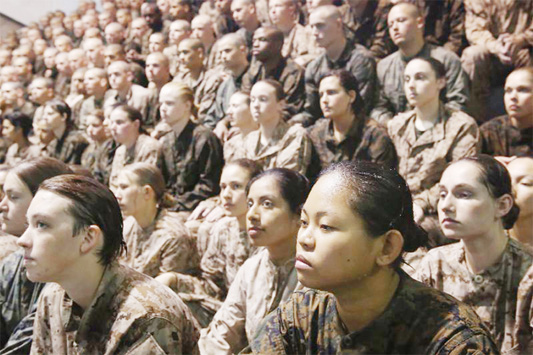
AFP, Washington :
Acting Defense Secretary Patrick Shanahan called for tougher action against sexual assault in the US military Thursday after an annual Pentagon report said the number of assaults in 2018 had risen from recent years.
Sexual assaults reported by Defense Department employees, both men and women, jumped 13 percent last year to 7,623 as compared to 2017.
Moreover, actual sexual assaults were likely to be about triple the reported number, given the estimate that just one out of three victims in the military file a complaint.
“It is clear that sexual assault and sexual harassment are persistent challenges,” Shanahan said in a statement.
“To put it bluntly, we are not performing to the standards and expectations we have for ourselves or for each other. This is unacceptable.” Based on a survey taken only every two years, the report said that not only the number but the prevalence of sexual assault was on the rise in 2018.
Around 6.2 percent of women in the Department of Defense experienced sexual assault or unwanted sexual contact in 2018, compared to 4.3 percent two years earlier, according to the report.
The level for men was much lower and relatively stable: 0.7 percent experienced assault in 2018, slightly higher than 0.6 percent two years ago.
The problem was worst in the Marines: some 10.7 percent of women in that service reported sexual assault last year, compared to 7.5 percent in the Navy and lower rates in the other services.
Sexual assaults on men from all services was in the 0.7-0.8 percent range.
But the overall estimates for assaults reported and not reported underscore the problem for both genders: last year, the Pentagon estimates, more than 13,000 women were assaulted and more than 7,000 men.
Assaults target youngest recruits
The report showed that the youngest women were at the highest risk, and that their attackers were like them most often of low rank, equal to or slightly higher than the victim.
That pointed to the need for more understanding of how younger recruits interact, especially with the rise of social media, according to experts.
“We have to look and see what is … happening with the 17-24 year-olds that our programs are not accounting for,” said Nate Galbreath, deputy director of the Pentagon’s Sexual Assault Prevention and Response Office.
“That is one the things that we want to investigate: to kind of see what risks are posed by using social media sites.”
Shanahan told a Congressional panel Wednesday that said he supported a proposal to seek a specific crime for sexual harassment under the military’s unique justice system.
COMMENT
“We will criminalize certain activities in this next year to reflect the seriousness that we take on certain behavior,” he said.
Acting Defense Secretary Patrick Shanahan called for tougher action against sexual assault in the US military Thursday after an annual Pentagon report said the number of assaults in 2018 had risen from recent years.
Sexual assaults reported by Defense Department employees, both men and women, jumped 13 percent last year to 7,623 as compared to 2017.
Moreover, actual sexual assaults were likely to be about triple the reported number, given the estimate that just one out of three victims in the military file a complaint.
“It is clear that sexual assault and sexual harassment are persistent challenges,” Shanahan said in a statement.
“To put it bluntly, we are not performing to the standards and expectations we have for ourselves or for each other. This is unacceptable.” Based on a survey taken only every two years, the report said that not only the number but the prevalence of sexual assault was on the rise in 2018.
Around 6.2 percent of women in the Department of Defense experienced sexual assault or unwanted sexual contact in 2018, compared to 4.3 percent two years earlier, according to the report.
The level for men was much lower and relatively stable: 0.7 percent experienced assault in 2018, slightly higher than 0.6 percent two years ago.
The problem was worst in the Marines: some 10.7 percent of women in that service reported sexual assault last year, compared to 7.5 percent in the Navy and lower rates in the other services.
Sexual assaults on men from all services was in the 0.7-0.8 percent range.
But the overall estimates for assaults reported and not reported underscore the problem for both genders: last year, the Pentagon estimates, more than 13,000 women were assaulted and more than 7,000 men.
Assaults target youngest recruits
The report showed that the youngest women were at the highest risk, and that their attackers were like them most often of low rank, equal to or slightly higher than the victim.
That pointed to the need for more understanding of how younger recruits interact, especially with the rise of social media, according to experts.
“We have to look and see what is … happening with the 17-24 year-olds that our programs are not accounting for,” said Nate Galbreath, deputy director of the Pentagon’s Sexual Assault Prevention and Response Office.
“That is one the things that we want to investigate: to kind of see what risks are posed by using social media sites.”
Shanahan told a Congressional panel Wednesday that said he supported a proposal to seek a specific crime for sexual harassment under the military’s unique justice system.
COMMENT
“We will criminalize certain activities in this next year to reflect the seriousness that we take on certain behavior,” he said.

